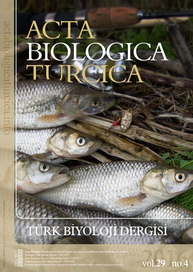Nutlet micromorphology and its taxonomic significance in Lamium sect. Amplexicaule (Lamiaceae)
Abstract
Keywords
Full Text:
PDFReferences
Atalay, Z., Celep, F., Bilgili, F., & Doğan, M. (2016a). Pollen morphology of the genus Lamium L. (Lamiaceae) and its systematic implications. Flora, 219, 68-84.
Atalay, Z., Celep, F., Bara, F., & Doğan, M. (2016b). Systematic significance of anatomy and trichome morphology in Lamium (Lamioideae; Lamiaceae). Flora, 225, 60-75.
Atasagun, B., Aksoy, B., & Martin, E. (2015). Contribution to the systematic knowledge of L. multifidum and L. orientale (Lamiaceae). Phytotaxa, 203(2), 147-158.
Barthlott, W. (1981) Epidermal and seed surface characters of plants: systematic applicability and some evolutionary aspects. Nordic Journal of Botany, 1, 345-355.
Bendiksby, M., Thorbek, L.B., Scheen, A.C., Lindqvist, C., & Ryding, O. (2011). An updated phylogeny and classification of Lamiaceae subfamily Lamioideae. Taxon, 60, 471-484.
Boissier, E. (1846). Diagnoses plantarum Orientalium novarum, vol. 7. [ser. 1] B. Hermann, Leipzig, 56-57.
Boissier, E. (1879). Flora Orientalis. vol. 4(2). H. Georg. Genevae & Basilea, 714-749.
Briquet, (1895–1897) Labiatae. In: Engler, A. & Prantl, K. (Eds.) Die Natürlichen Pflanzenfamilien, vol 4. Wilhelm Engelmann, Leipzig, 183-375.
Celep, F., Kahraman, A., Atalay, Z., & Doğan, M. (2011). Morphology, anatomy and trichome properties of Lamium truncatum Boiss. (Lamiaceae) and their systematic implications. Australian Journal of Crop Sciences, 5(2), 147-153.
Celep, F., Kahraman, A., Atalay, Z., & Doğan M. (2014). Morphology, anatomy, palynology, mericarp and trichome micromorphology of the rediscovered Turkish endemic Salvia quezelii (Lamiaceae) and their taxonomic implications. Plant Systematics and Evolution, 300, 1945-1958.
Celep, F. (2017). Lamium bilgilii (Lamiaceae), a new species from South-western Türkiye (Burdur-Muğla). Phytotaxa, 312, 263-270.
Celep, F., Karaer, F., & Duman, H. (2021). Resurrection of Lamium ponticum (Lamiaceae) with a new subspecies, Lamium ponticum subsp. anatolicum, from Türkiye. Phytotaxa, 511, 071-076.
Celep, F., Karaer, F., & Drew, B.T. (2022a). Lamium cappadocicum, a new species from Central Anatolia, Türkiye: evidence from molecular and morphological studies. Turkish Journal of Botany, 46(6), 614-623.
Celep, F., Kahraman, A., Guerin, G.R., Karabacak, E., Akaydın, G., & Doğan, M. (2022b). Nutlet micromorphology and its taxonomic and phylogenetic significance in Salvia (Lamiaceae). Plant Biosystems- An international Journal Dealing with All Aspects of Plant Biology, 156(1), 271-283.
Duman, H. (2000). Lamium L. In: Güner A, Özhatay N, Ekim T, Başer KHC (eds) Flora of Türkiye and East Aegean Islands, vol 11, 199-200.
Govaerts, R., Paton, A., Harvey, Y., & Navarro, T. (2010). World checklist of Lamiaceae and Verbenaceae. Kew, Richmond: The Board of Trustees of the Royal Botanic Gardens. http://www.kew.org/wcsp/lamiaceae/, Accesed 1 April 2016.
Harley, R.M., Atkinson, S., Budantsev, A.L., Cantino, P.D., Conn, B.J., Grayer, R., Harley, M.M., De Kok, R., Krestovskaja, T., Morales, R., Paton, A.J., Ryding, O., & Upson, T. 2004. Labiatae. In: Kadereit, J.W. (Eds.), The families and genera of vascular plants, vol 7, Springer, Berlin, 167-275.
Jamzad, Z. (2012). Eremostachys and Phlomis. In: Assadi, M., Maassoumi, A.A. & Mozaffarian, V. (Eds.). Flora of Iran 76. ResearchInstitute of Forest and Rengelands, Tehran, 253-337.
Kahraman, A., Celep, F., Doğan, M., Guerin, G.R., & Bagherpour, S. (2011). Mericarp morphology and its systematic implications for the genus Salvia L. section Hymenosphace Bentham (Lamiaceae) in Türkiye. Plant Systematics and Evolution, 292, 33-39.
Krawczyk, K., & Sawicki, J. (2013). The uneven rate of the molecular evolution of gene sequences of DNA-Dependent RNA polymerase I of the genus Lamium L. International Journal of Molecular Sciences, 14(6), 11376-11391.
Krawczyk, K., Szczecinska, M., & Sawicki, J. (2014). Evaluation of 11 single-locus and seven multilocus DNA barcodes in Lamium L. (Lamiaceae). Molecular Ecology Resources, 14, 272-285.
Krawczyk, K., & Glowacka, K. (2015). Nutlet micromorphology and its taxonomic utility in Lamium L. (Lamiaceae). Plant Systematics and Evolution, 301(7), 1863-1874.
Mennema, J. (1989). A taxonomic revision of Lamium (Lamiaceae). Leiden Bot. Ser. Vol. 11.
Mill, R. R.(1982). Flora of Türkiye and East Aegean Islands Lamium L. vol. 7. In: Davis, P. H. 8ed). University of Edinburgh Press, Edinburgh.
Moon, H.K., Smets, E., & Huysmans, S. (2010). Phylogeny of tribe Mentheae (Lamiaceae): The story of molecules and micromorphological characters. Taxon, 59(4), 1065-1076.
Parsa, A. 1948-60. Flore de I’ Iran. Vol. 8, Ministere de I’Education. Tehran.
Ryding, O. 1994. Pericarp structure and phylogeny of Lamiaceae subfamily Pogostemonoideae. Nordic Journal of Botany, 11(1), 59-63.
Ryding, O., 2003. Reconsideration of Wiedemannia and notes on the circumscription of Lamium (Lamiaceae). Botanische Jahrbücher fur Systematik, Pflanzengeschichte und Pflanzengeographie, 124, 325-335.
Ryding, O. 2010. Pericarp structure and phylogeny of tribe Mentheae (Lamiaceae). Plant systematics and evolution, 285(3-4), 165-175.
Salmaki,Y., Zarre,S., & Jamzad, Z. (2008). Nutlet morphology of Stachys (Lamiaceae) inIrananditssystematic implication. Feddes Repertorium, 119(7–8), 631-645.
Salmaki, Y., Bendiksby, M., & Heubl, G. (2015). Molecular phylogeny confirms the placement of enigmatic Stachys persepolitana in Lamium (Lamiaceae; subfam. Lamioideae). Phytotaxa, 4, 254-266.
Scheen, A. C., Bendiksby, M., Ryding, O., Mathiesen, C., Albert, V.A. & Lindqvist, C. (2010). Molecular phylogenetics, character evolution, and suprageneric classification of Lamioideae (Lamiaceae). Annals Missouri Botanical Garden, 97, 191-217.
Schols, P., Dessein S., D’hondt C., Huysmans, S., & Smets, E. (2002). Carnoy: a new digital measurement tool for palynology. Grana, 41, 124-126.
Stearn, W. T. (2004). Botanical Latin. London.
Refbacks
- There are currently no refbacks.

